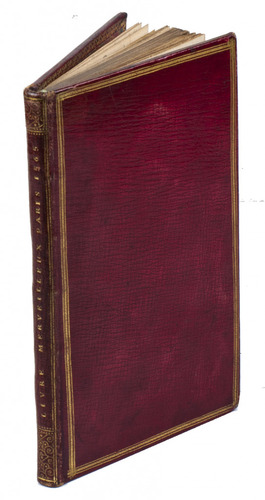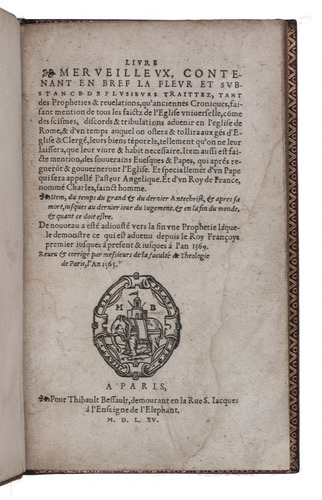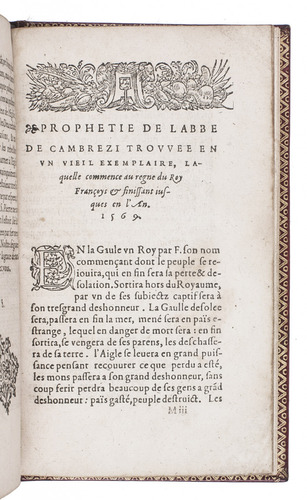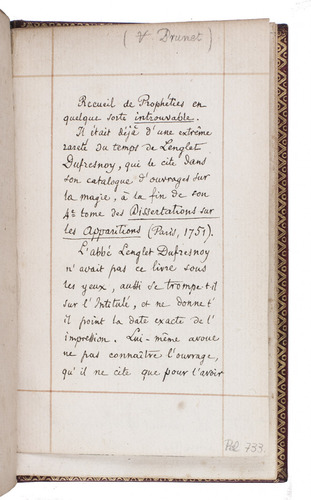[TELESFORO DA COSENZA].
Livre merveilleux, contenant en bref la fleur et substance de plusieurs traittez, tant des propheties & revelations, qu'anciennes croniques, faisant mention de tous les faictz de l'Eglise Universelle, co[m]me des scismes, discords & tribulations advenir en l'Eglise de Rome, & d'un temps auquel on ostera & tollira aux ge[n]s d'eglise & clergé, ...
Paris, Thibault Bessault, 1565. 8vo. With Bessault's woodcut device on the title-page. 18th-century French grained red morocco (ca. 1745?), gold-tooled spine with pointillé ornaments, each board framed with thin-thick-thin fillets with a rosette(?) stamped over their intersections at the corners, gold-tooled turn-ins, gold fillets on the board edges, gilt edges. [54] ll.
€ 12,500
Extremely rare (third copy known?) and much sought second dated French edition (Bessault published the first earlier in the same year, but augmented it for the present edition) of a collection of fascinating and very intriguing prophecies about the Catholic Church and the coming of the Antichrist, dedicated by the Italian Franciscan hermit Tellesforo da Cosenza (presumably the compiler and perhaps even author) to "Anthoine, noble Duc de Gennes", meaning Antoniotto Adorno (1340-1398), who was 6th Doge of Genoa. The Avignon Papacy had been notorious for its corruption before 1377 and Tellesforo claims the prophecies were compiled from the writings of Gioacchino da Fiore (ca. 1130-1202), so they supposedly foretold Avignon's past troubles, giving credence to their predictions of further troubles still to come. It also predicts a new royal house in France in 1584, not far off of the Bourbons in 1589. Renouard attributes the French translation to Guillaume Postel (1510-1581).
From the library of Stanislas de Guaita (1861-1897), a Paris poet and novelist from an Italian noble family, with his gold-blocked armorial bookplate on red leather on the front paste-down. He was a Rosicrucian and made use of occultism and magic in his literary work. Although the binding is unsigned, the 1899 catalogue of Guaita's library attributes it to Derome, and the book has a printed description of what must be the same copy from Morgand's 1894 catalogue of the Hyppolyte Destailleur (1822-1893) collection. The 1894 catalogue notes that it came from "Beckford", presumably William Beckford (1760-1844), whose collection was sold in 1882.
The binding was attributed to Derome in the 19th-century and is certainly work of very high quality. The endpapers include a watermark date "1743", so it was probably bound soon after that, which means it could be the work of Jacques-Antoine Derome (ca. 1696-1760) or one of his two older sons, but not Nicolas-Denis, who became a master binder only in 1761.
Very slightly browned and with occasional mostly marginal water stains, one on the title-page, but still in very good condition. The binding is also very good, with only slight wear at the extremities. An extremely rare early edition of an important occult work and attack on Church corruption, finely bound ca. 1750. French vernacular books 49007 (3 [recté 2?] copies); Stanislas de Guaita et sa Bibliotheque Occulte (1899), item 952 (the present copy); D. Morgand, Cat. de livres .. à l'histoire de ... Paris ... provenant de ... Hyppolyte Destailleur (1894), 23535 (the present copy); Renouard, Imprimeurs ... Parisiens 378 (2 copies [recté 1 copy?]).
Related Subjects:







